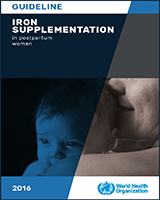Anaemia is a condition in which there is too little haemoglobin, which is carried by red blood cells, thereby decreasing the capacity of the blood to carry sufficient oxygen to meet physiological needs. There are a number of causes of anaemia, including blood loss, iron deficiency and other micronutrient deficiencies (e.g. vitamin A, folate, vitamin B12 and riboflavin), inherited haemoglobin disorders (e.g. sickle-cell disease and thalassaemias), parasitic infections and other acute and chronic infections that cause inflammation (4). Iron deficiency often occurs before anaemia and is considered to be one of the most common forms of nutritional anaemia.
In comparison with pregnancy, maternal iron requirements usually decline during the postpartum period, defined as the period beginning just after childbirth throughout the subsequent 6 weeks (8). However, this period may serve as a time to restore iron lost during pregnancy and delivery. Maternal iron stores are not utilized for production of breast milk, since very little iron is excreted through breast milk (9, 10). Nevertheless, one of the strongest predictors of postpartum anaemia is anaemia during pregnancy, as iron stores tend to remain low for several months after childbirth, especially if there is significant blood loss during the delivery and additional iron is not consumed in sufficient quantities (11–13). Worldwide, there are limited data on the prevalence of postpartum anaemia. Studies conducted in high-income countries have reported that 10–30% of postpartum women were anaemic (8, 11, 14–16). Larger datasets for all women of reproductive age and pregnant women suggest that anaemia is a common problem throughout the world (17, 18) and the prevalence of anaemia in postpartum women may be higher in low- and middle-income countries, as compared to published figures for postpartum women in high-income countries.
Iron deficiency and anaemia during the postpartum period may have long-term health implications for the mother and her infant. Mothers with low iron stores at the time of delivery and following childbirth may experience fatigue, altered cognition and depressive symptoms (19). These alterations in the mother’s emotional and cognitive functioning may, in turn, affect her interactions with the infant and may negatively impact infant behaviour and development (20). If iron stores are not restored soon after childbirth, the negative consequences of postpartum iron deficiency and anaemia may continue through other stages of the reproductive cycle, particularly in areas where there is a high prevalence of anaemia and among women consuming diets that are low in bioavailable iron and who have short inter-pregnancy intervals (less than 18 months); this can lead to continued adverse maternal and infant outcomes (21–24).
WHO and the Food and Agriculture Organization of the United Nations recommended nutrient intake for iron in lactating women ranges from 10 to 30 mg per day (25), depending on the bioavailability of dietary iron (26). Iron absorption is affected by the type of iron in the diet. Non-haeme iron is the main form of dietary iron and is present in many vegetables. Its absorption is affected by an individual’s iron status and by several factors in the diet, including phytates, iron-binding phenolic compounds, and calcium, which decrease absorption, and ascorbic acid, which facilitates absorption (26). Conversely, the absorption of haeme iron, present only in meat, poultry and fish, is less affected by dietary factors and is regulated by the iron status of an individual and the total amount of dietary haeme iron consumed. Iron supplementation has proven to be effective for increasing haemoglobin concentrations among pregnant and non-pregnant women (27–30), and iron supplementation has been recommended as a public health approach to improve maternal and infant health outcomes in different age groups (4). In some women, the oral consumption of iron supplements has been associated with side-effects affecting the gastrointestinal system, such as diarrhoea, constipation, nausea and vomiting (4). These symptoms generally increase in severity with increasing amounts of elemental iron and when the supplement is taken on an empty stomach. An increased incidence of gastrointestinal side-effects in adults receiving 25–222 mg of elemental iron daily as ferrous sulfate, the most common iron compound prescribed, compared to those receiving a placebo, has been reported, but the relationship between gastrointestinal side-effects of supplementation and the dose of iron remains unclear (31).

